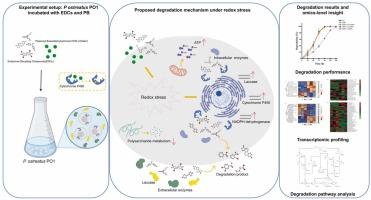平菇GEMB-PO1降解多种内分泌干扰化合物的综合酶学、转录组学和代谢物鉴定
IF 11.3
1区 环境科学与生态学
Q1 ENGINEERING, ENVIRONMENTAL
引用次数: 0
摘要
内分泌干扰化合物(EDCs)是一类重要的微污染物,持续存在于环境中,威胁生态和人类健康。本研究考察了平耳(Pleurotus ostreatus) GEMB-PO1对8种典型edcs的降解能力,即双酚A (BPA)、双酚F (BPF)、四溴双酚A (TBBPA)、邻苯二甲酸丁苯酯(BBP)、邻苯二甲酸二丁酯(DBP)、邻苯二甲酸二(2-乙基己基)酯(DEHP)、17β-雌二醇(E2)和雌酮(E1)。酶活性测定和抑制剂实验证实了cyp450和漆酶在介导细胞内和细胞外转化过程中的协同作用。转录组学分析显示,EDC暴露触发了一个涉及cyp450、漆酶、NAD(P) h依赖性脱氢酶和次级代谢物生物合成途径的协调基因网络的激活,表明真菌范围内的代谢重编程以应对氧化和外源应激。LC-MS鉴定了化合物特异性的中间代谢物,并实现了逐步降解途径的重建。虽然在不同的化合物中观察到不同的降解途径,但大多数都集中在氧化转化上,并伴随着脱烷基或水解,这取决于分子结构。据我们所知,这是第一个整合酶、转录组学和代谢物水平证据的研究,以系统地解决单一真菌菌株对结构多样的EDCs的降解机制。这些发现扩大了对真菌降解EDC的机制理解,并突出了P. ostreatus GEMB-PO1的生物修复潜力。本文章由计算机程序翻译,如有差异,请以英文原文为准。

Integrated Enzymatic, Transcriptomic, and Metabolite Identification Insights into the Degradation of Diverse Endocrine-Disrupting Compounds by Pleurotus ostreatus GEMB-PO1
Endocrine-disrupting compounds (EDCs) represent a significant class of micropollutants that persist in environments and threaten ecological and human health. In this study, Pleurotus ostreatus GEMB-PO1 was investigated for its ability to degrade eight representative EDCs—bisphenol A (BPA), bisphenol F (BPF), tetrabromobisphenol A (TBBPA), butyl benzyl phthalate (BBP), di-n-butyl phthalate (DBP), di(2-ethylhexyl) phthalate (DEHP), 17β-estradiol (E2), and estrone (E1). Enzymatic activity assays and inhibitor experiments confirmed the synergistic roles of CYP450s and laccases in mediating intracellular and extracellular transformation processes. Transcriptomic analysis revealed that EDC exposure triggered the activation of a coordinated gene network involving CYP450s, laccases, NAD(P)H-dependent dehydrogenases, and secondary metabolite biosynthesis pathways, suggesting a fungal-wide metabolic reprogramming to cope with oxidative and xenobiotic stress. LC-MS identified compound-specific intermediate metabolites and enabled the reconstruction of stepwise degradation pathways. While distinct degradation pathways were observed among different compounds, most converged on oxidative transformations, accompanied by dealkylation or hydrolysis depending on molecular structure. To our knowledge, this is the first study to integrate enzymatic, transcriptomic, and metabolite-level evidence to systematically resolve the degradation mechanisms of structurally diverse EDCs by a single fungal strain. These findings expand the mechanistic understanding of fungal EDC degradation and highlight the bioremediation potential of P. ostreatus GEMB-PO1.
求助全文
通过发布文献求助,成功后即可免费获取论文全文。
去求助
来源期刊

Journal of Hazardous Materials
工程技术-工程:环境
CiteScore
25.40
自引率
5.90%
发文量
3059
审稿时长
58 days
期刊介绍:
The Journal of Hazardous Materials serves as a global platform for promoting cutting-edge research in the field of Environmental Science and Engineering. Our publication features a wide range of articles, including full-length research papers, review articles, and perspectives, with the aim of enhancing our understanding of the dangers and risks associated with various materials concerning public health and the environment. It is important to note that the term "environmental contaminants" refers specifically to substances that pose hazardous effects through contamination, while excluding those that do not have such impacts on the environment or human health. Moreover, we emphasize the distinction between wastes and hazardous materials in order to provide further clarity on the scope of the journal. We have a keen interest in exploring specific compounds and microbial agents that have adverse effects on the environment.
 求助内容:
求助内容: 应助结果提醒方式:
应助结果提醒方式:


